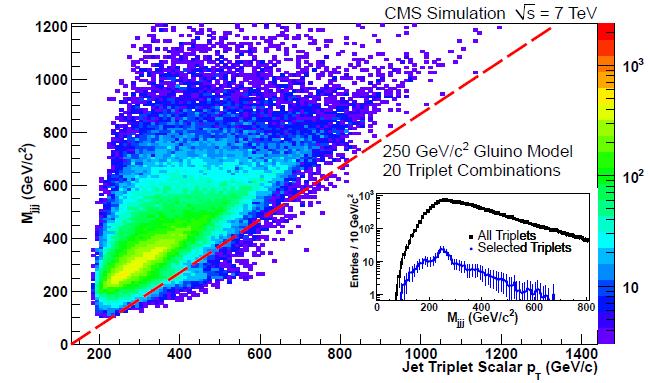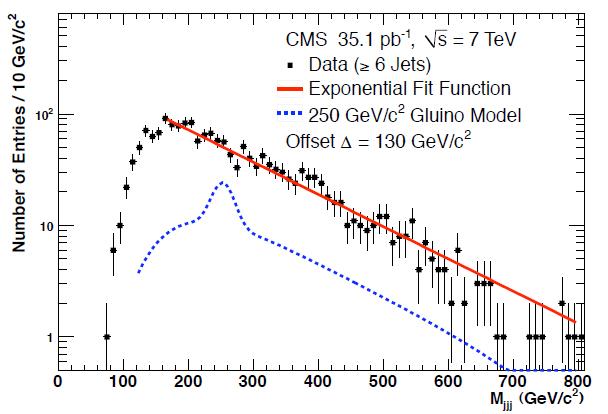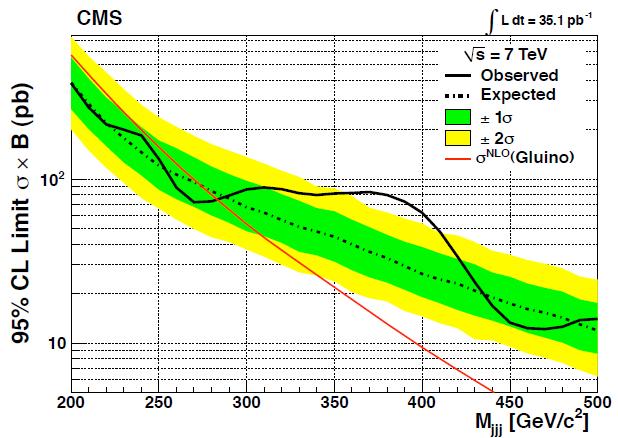Gluinos are particles predicted by supersymmetric models. They are the super-partner of the gluon, the carrier of strong interactions. If they exist, gluinos must be copiously produced in proton-proton collisions, because they carry the colour charge which "couples" them to standard quarks and gluons contained in the proton. In a few models including so-called "R-parity violation", gluinos will produce three hadronic jets in their decay, and so the final state of gluino pair production may indeed feature six energetic jets.
Six-jet events arise warm memories in this researchers' mind -I worked at them when the top quark was still at large, and the CDF-Padova group was challenging the enormous QCD background to spot the tiny signal of a all-hadronic decay of the top-quark pairs we hoped the Tevatron collider was producing.
Memories...
This happened in 1992, when I was still a undergraduate student. Back then, the top quark pairs were sought in much more promising final states which included at least one charged lepton by several groups in CDF; nobody else had the guts to waste their time looking for the six-jet final state. But the latter was also the most frequent decay mode, when both W bosons yielded by the top decay (t->Wb) would disintegrate into pairs of energetic hadronic jets. Four jets from the W pair, plus two from the b-quarks, made six jets in 45% of all top pair decays. Unfortunately, six jets could be produced by strong interaction processes (what I already called QCD in short above), at a rate over a thousand times larger than the signal. What to do to discriminate signal and background better ?
One way was to look for kinematical variables which would be different. After all, we knew that the six jets arose from a chain of decays but three of them should together make the total invariant mass of a top quark: so if we found two triplets whose invariant masses were close together, we could infer that the event was coming from the signal. Since there are twenty possible ways to choose a triplet in a set of six, however, the requirement never worked well, and we rather chose to use other more discriminating kinematical properties of the events. The analysis was successful and produced the first observation of the top quark pair decay into six jets, in 1997.
The CMS Gluino Search
Now, CMS is not finding something different from what we had found much earlier on with CDF: to see a gluino pair decaying into two jet triplets, they also have to fight the 20-fold ambiguity. However, the cross section for gluino pair production is larger than the top quark pair production for much of the parameter space, and on the other hand the detailed kinematics of the signal decay depends on the precise parameter space point where you are sitting. These two facts make a search based on the observable quantity that we had discarded in CDF long ago actually promising: the larger cross section allows for a tight selection of possible triplets; the wish to remain inclusive makes it less promising to find more specific kinematical quantities.
The figure below shows how a gluino pair production signal behaves, for gluino mass of 250 GeV, in the plane of triplet mass versus triplet scalar sum of jet transverse momenta. The mass of the correct combination "sticks out" at 250 GeV in events with large value of sum Pt. Retaining the few triplets which fall on the right of the red line strongly reduces the surviving signal, but it provides it with a very distinct shape in the triplet invariant mass distribution -as highlighted by the inset on the lower right: a bump appears at the correct mass in the otherwise smooth distribution.

All triplets in the data passing the criterion are then drawn in a histogram of the triplet mass: one expects a exponentially falling distribution for QCD background triplets, while a more complex structure with a bump at the right mass would be produced by the signal triplets. This is shown in the figure below: black points are the 2010 CMS data, and the blue curve shows what would be the contribution of a 250 GeV gluino. The label "offset 130 GeV" indicates the exact value of the cut applied on the triplets, which is specified by the minimum value of Sum Pt - mass (130 GeV) which triplets must have to pass the selection. The choice of 130 GeV was chosen based on a simple optimization criterion (a bit too simple if you ask me, but well...)

Results
 As you can see by yourself, there appears to be no Gaussian enhancement anywhere in the spectrum (except maybe some upward fluctuation around 380 GeV). From the smoothness of the distribution CMS extracts a limit on the amount of signal present in the data: this is then turned into an upper limit in the cross section that the gluino signal must have in order to have escaped detection (black curve in the figure on the right). A comparison with the cross section predicted by the theoretical model (red curve) allows to exclude that gluinos exist if their mass is below 280 GeV. The limit extends upward the one of past Tevatron searches by 136 GeV.
As you can see by yourself, there appears to be no Gaussian enhancement anywhere in the spectrum (except maybe some upward fluctuation around 380 GeV). From the smoothness of the distribution CMS extracts a limit on the amount of signal present in the data: this is then turned into an upper limit in the cross section that the gluino signal must have in order to have escaped detection (black curve in the figure on the right). A comparison with the cross section predicted by the theoretical model (red curve) allows to exclude that gluinos exist if their mass is below 280 GeV. The limit extends upward the one of past Tevatron searches by 136 GeV.For more details about the CMS search, please read the paper in the arxiv.




Comments